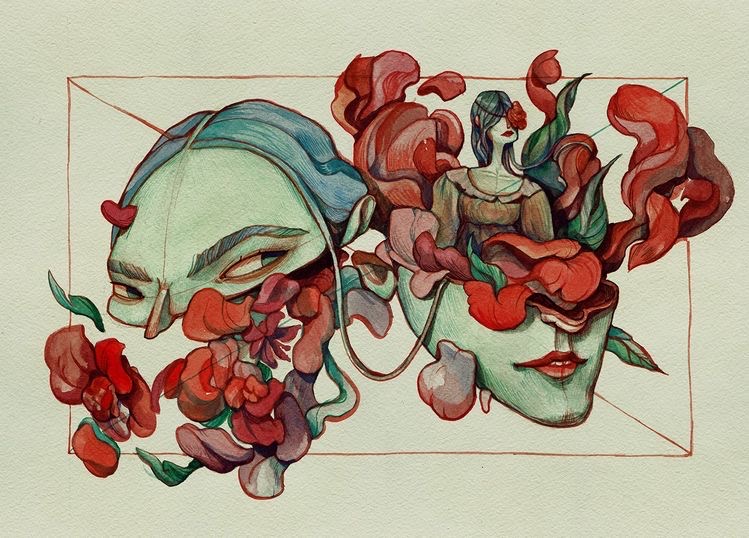Asian Feminism sits in a tricky position between White and other intersectional forms of feminism, unsure of where its purpose truly fits in with other mainstream movements.
This uncertainty stems from a longstanding exclusion of Asian voices from popular culture — considered “too Asian” or “too dark” to fit in with White feminism, yet not able to find common ground with the issues that Black and Latina women encounter. Unable to share the privileges that white women have or are unable to empathize with the systemic barriers that Black women face throughout their lives, Asian feminism is usually ostracized from other movements under this umbrella.
Today, white feminist movements do not encompass the intersectional struggles of BIPOC persons — race, class, ethnicity, etc. Therefore cannot accurately account for “white-passing” or “whitewashed” Asians, who share the struggles with other Asians, not the privileges of the white women they aim to identify with. No matter one’s stance and relationship with their Asian heritage, there is no way White feminism can effectively address the stereotypes and misinformation surrounding Asian women and culture in Western society’s eyes.
As an Asian woman in a Western-dominated society, it is impossible for White feminism to wholly and effectively amplify their voices — voices of those that encounter issues of race and ethnicity in addition to the universal fight for women’s rights.
In this acknowledgement that as a member of the Asian American youth, dismantling the obstacles that hinder Asian American feminism from having a distinct, heard voice in the sea of mainstream and White feminism needs to become a priority.
Issues like toxic masculinity, under-representation of Asian men and women in Western culture, the sexualization of Asian women and the emasculation of men, homophobia, colorism, overt/covert racism from non-Asians, internalized racism, xenophobia, and numerous more issues all fall under Asian feminism.
(Note that feminism is not limited to simply “women’s issues.” A fight for equality is a fight for everyone, whether they identify as a man, woman, non-binary, or any gender. A misconception in the media is that many feminists want to oppress men only to alleviate and give power to women. This is not true. Feminism is a fight for equality for all, which means bringing attention to men’s issues, too.)
One of the initial struggles in amplifying the voices of Asian Feminism is the oriental and cultural barriers that have long defined Asian cultures throughout history, preventing the spread of contemporary feminist ideologies as they clash with cultural archetypes. Traditional Oriental culture portrays women as beings of filial piety, virtue, and submission. At the same time, men are viewed as the “bread-winners,” responsible for holding up their families and asserting dominance and order. Asian women are expected to maintain these qualities to appeal to a potential husband, which — in the context of the feminist movement — compromises the fight for freedom and autonomy for women who are forced otherwise.
These long-standing patriarchal and sexist standards put many women at risk of domestic abuse and sexual/physical/emotional abuse in general. “56% of Filipinas and 64% of Indian and Pakistani women had experienced sexual violence by an intimate in a study of 143 domestic violence survivors” (Intimate Partner Violence and Help-Seeking, 2011). Attitudes towards family/domestic violence occurred consisted of the husband wanting “power, domination, and control (72 [of 607] responded this way) and that he is frustrated/has anger (67 responded this way)” (ATASK: Asian Family Violence Report, 2000). Many reported that the woman should stay quiet about the abuse — a sentiment shared in many Asian cultures.
The enforced archetype of submission and passiveness in Asian women has caused a taboo in Asian cultures surrounding mental health, abuse, rape, and assault. Enforced by these cultural ideals that women need to remain obedient and refrain from complaining; this attitude has taken its toll on survivors of assault and abuse, many unable to work up the strength to speak out against their abusers in the fear that they will be reprimanded for doing so.
Hand-in-hand with the issue of reducing Asian women to submissive and obedient members of a highly misogynistic culture, this ideal threatens the liberation of LGBTQIA+ men and non-binary, gender fluid individuals. Toxic masculinity limits the definition boundaries separating men from women, causing shame in men that express or identify with more feminine qualities — wearing makeup, dressing in more feminine clothing, or participating in anything considered more “womanly.” In a historically patriarchal society and in the face of anti-LGBTQIA+ institutions throughout Asia, LGBTQIA+ men face extreme homophobia, discrimination, and hate from other members of their own culture, often targets of biased-motivated hate crimes and assault.
While many Asian women are pushing the boundaries of this sphere of honor and compliance and dismantling patriarchal views to liberate LGBTQIA+ and non-conforming men to identify more with the current mainstream wave of feminism — making bold statements and challenging norms — they often find themselves stuck in being viewed as the “dishonorable child” or the “rebelling daughter” in doing so, frowned upon by family for “disrespecting” their culture. This double standard for Asian women has prevented Asian American feminism from being accepted by women from cultures that uphold more solid gender roles. Asian women that were raised traditionally find themselves in a predicament between contemporary feminist ideals of independence versus the normalized patriarchy enforced by their own culture.
What is seen in the anxiety surrounding upholding tradition is the danger of following liberation movements when contested with cultural norms. Women who attempt to break free of a culture in which sexism is unquestioned and accepted face many external challenges — the fear of being a disappointment, not being able to actively fit into mainstream liberation movements, being ostracized from their own culture, and more. These fears outline more struggles which White feminism does not account for, further emphasizing the need for more voices to be amplified in Asian American feminism specifically to address Asian American issues.
The shame catalyzed by internalized racism in Asians has fueled movement away from Asian pride and towards Western culture. Therefore, instead of assimilating and attempting to identify with White feminism, the rise of Asian feminism is a push towards de-centering the conversation from whiteness and highlighting the sectional struggles specific to Asian women.
Asians are often viewed as “perpetual foreigners,” which has caused many Asians to succumb to Western archetypes in hopes of being separated from the negative stereotypes that popular culture marks Asians with. A step towards amplifying Asian feminism is to relieve Asians of their shame and guilt surrounding negative stereotypes to be able to put their communities at the center of this conversation for liberation.
In taking pride in their heritage and culture, Asian Feminism opens doorways for those involved to battle xenophobia and acknowledge the contributions of Asian workers towards American corporations and upholding capitalist systems. Issues surrounding the exploitative working conditions of Asian men and women to supply U.S. brands are a responsibility of Asian feminism to address and an issue worth amplifying, in which this movement can also become humanitarian as well as environmental — encouraging the shift away from fast fashion brands that abuse workers to more sustainable and moral options.
Tradition and culture can often hold one back from following and supporting liberation movements like the Asian feminist movement. While maintaining cultural appreciation and respect is vital, it is just as important to take steps to dismantle harmful and oppressive practices in these cultures, still maintaining its unique and beautiful aspects just as readily. The issues listed in this article is only a brief start to the many problems that Asian American Feminism is battling. Fighting racism, xenophobia, sexism, etc. is a fight universal to all feminist movement sections. Still, the social and cultural implications of these issues in the Asian community distinguish them from its context in the White feminist movement, or any other sectional movement focused on women’s liberation.
Although the path to amplifying the voices in Asian Feminism seems like a long and winding path ahead, the fight for the amplification of Asian voices in this movement of liberation and quality is in full speed — active feminist icons pushing for Asian representation and organizations like the Asian American Feminist Collective opening doorways for the public to get involved.
Amplifying the voices in Asian feminism takes away the shame and stigma surrounding liberation movements in the context of Asian culture. It gives intersectional issues opportunities to be brought to attention, providing the tools for this generation and the next to create a better world.
“…Uncovering the intersections, refusing to have our communities aggregated into neat racial packages, airing our dirty laundry, diverging from (sometimes self-) prescribed monolithic identities, and disrupting the vast erasures of our history across the diaspora is a start to re/building Asian America.”
– Alison Roh Park, 2016
Asian American Feminist Collective website: https://www.asianamfeminism.org/
Sources
Cover art by Marija Tiurina
https://planamag.com/what-does-asian-feminism-mean-to-me/
https://www.ukessays.com/essays/psychology/feminism-in-the-asian-culture.php
Intimate Partner Violence and Help-Seeking (2011)
ATASK: Asian Family Violence Report (2000)
https://www.api-gbv.org/about-gbv/statistics-violence-against-api-women/



